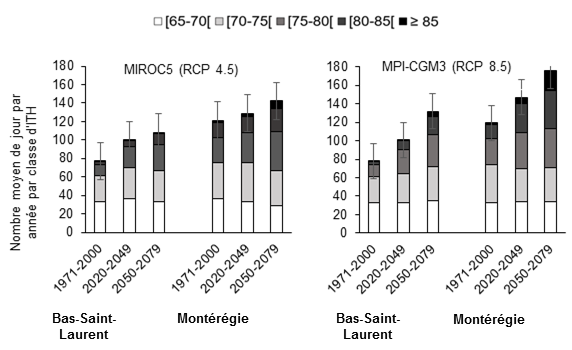Choice of Forage Grass and Mitigation of Heat Stress for Cows on Quebec Dairy Farms in the Context of Climate Change
The results obtained make it possible to provide dairy farm managers with concrete recommendations for choosing forage mixes adapted to current and future climate conditions and solutions to reduce the risk of heat stress in barns during hot summer weather.
Project details
Principal(s) investigator(s)

Context
The projected climate change will lead to higher temperatures, a greater accumulation of degree days, and changes in rainfall distribution. The effects of some of these changes are such that Timothy grass, which is adapted to cool and wet conditions, will prove to be less advantageous than other grasses in Quebec, where it is currently the most popular type of forage.
The option of feed mixtures remains relevant but requires species better adapted to the new climate conditions. Climate change will also affect the thermal environment in which dairy cows evolve and can potentially have major impacts on their performance, and ultimately that of the dairy industry.
Pressure from heat stress on cows is currently one of the biggest challenges associated with climate in several regions of the world and is likely to become a problem in Canada as well, considering the projected climate change.
Objective(s)
-
Evaluate the potential impact of climate change on the new recommendations issued by forage associations as well as on the performances of cows on dairy farms in Quebec.
Methodology
-
Calculation of the projected potential returns for new combinations of forage species, and assessment of the expected evolution of heat stress risks and their effects on the performance of dairy cows in Quebec under different climate scenarios;
-
Analysis of the impacts on the techno-economic and agri-environmental results of Quebec dairy farms; Identification of the key climate change adaptation measures used on dairy farms in Quebec and elsewhere in North America;
-
Analysis of the implementation of different climate change adaptation measures on the techno-economic and agri-environmental results (balance N and P, production of GHG) of Quebec dairy farms.
Results
The results of the survey of 194 Quebec dairy producers in 2016 showed that some impacts associated with climate change are already noticeable in the southern part of the province (increase in the number of cuts per season, winter alfalfa mortality).
The producers surveyed anticipated a greater impact of climate change on crops than on animals (Figure 1). In addition, most respondents felt that the current state of their barn would make it possible to limit the potential impacts of climate change on animals.

Figure 1: Area of the business where the impact of climate change will be most significant based on respondent’s responses
Projected yields and simulated nutritive value of forage mixtures on virtual typical dairy farms in the Bas-Saint-Laurent and Montérégie regions for the periods 2020‒2049 and 2050‒2079 indicated that the meadow fescue-alfalfa mixture obtained the highest yields while the meadow bromegrass-alfalfa mixture obtained the highest crude protein levels.
The higher yields of the tall fescue-alfalfa mixture resulted in the highest net benefits in the Lower St. Lawrence, while the brome/alfalfa mixture had the best results in the Montérégie. In fact, these same two combinations provide the lowest nitrogen and phosphorus balances in their respective regions. Finally, all the mixtures have comparable GHG balances.
Characterization of the climate conditions on the farms studied showed that the average summer temperature-humidity index was already high enough to cause heat stress in dairy cows. In addition, our results showed that an accumulation of days with a temperature-humidity index greater than 65 (indicator of heat stress) was associated with a reduction in daily fat and protein content in the milk of dairy cows.
Projected future fat and protein production (periods 2020‒2049 and 2050‒2079) under six climate scenarios were lower than those obtained during the reference period (1971‒2000) due to an increase in the number of days with a high temperature-humidity index (heat stress) (Figure 2). Animal performance could therefore decrease in the future if no mitigation strategy is put in place.
These decreases would result in monetary losses of up to $583 and $574/cow/year in the Bas-Saint-Laurent and Montérégie regions respectively. Ultimately, the addition of recirculation fans proved profitable for dairy producers in Bas-Saint-Laurent and Montérégie for both future time horizons considered. For its part, the addition of a misting system was only profitable in Montérégie for the two future time periods.

Figure 2:Mean (± standard deviation) of the annual number of days with a temperature-humidity index (THI) over 65 and by THI class under two climate scenarios for three periods The figure shows an increase in the frequency and intensity of heat stress events in the future.
Benefits for adaptation
Benefits for adaptation
Ultimately aimed at optimizing the sustainability of the Quebec dairy industry, the results obtained make it possible to provide dairy farm managers with concrete recommendations for choosing forage mixes adapted to current and future climate conditions and solutions to reduce the risk of heat stress in barns during hot summer weather.
Scientific publications
Funding





Other participants
-
Agriculture and Agri-Food Canada
-
University of Madison - Wisconsin
-
Institut de recherche et de développement en agroenvironnement (IRDA)
-
Université Laval
-
Valacta